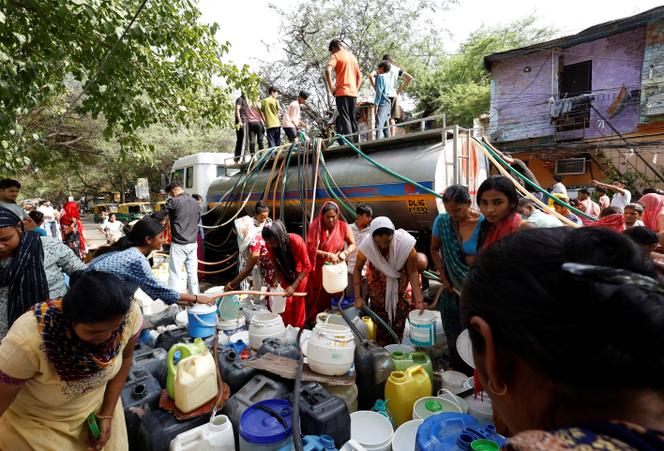


Dozens of cans, jerry cans and plastic buckets were piled up on both sides of the main street of Vivekanand Camp, on the edge of the upscale Chanakyapuri district in southern New Delhi. They were dropped off by residents the day before or at dawn. Water was no longer flowing into this informal settlement, while the thermometer in the Indian capital has barely dipped below 43 °C since mid-May, with peaks of up to 52 °C. The megalopolis is experiencing the longest heatwave in its history. A government tanker passes there twice a day.
From 6:30 am onward, it was stormed by youngsters jostling and fighting to climb onto the roof and install their pipes. Downstairs, a family member filled the containers. In half an hour, the whole affair was over, and men and women rushed down the tiny alleyways, carrying their precious tubs home. The neighborhood has a communal pump, but it has run dry.
Pushpa, 36, was born in the slum to parents who arrived from Nepal. She lives in a two-room, two-story brick shack, with no windows or water taps, but with a TV and an air-conditioning unit. The mother of the family prefers not to give her name, as she works part-time as a cook in a nearby embassy. She fears that the arrival of the media will prompt the authorities to throw her and her family out.
This illegal camp, of which there are dozens in the Indian capital, developed over 25 years ago with the arrival of migrants from neighboring regions, who were too poor to rent a room or apartment. The contrast with the immediate environment was striking. The perimeter of the embassies was a jewel box of greenery, lush gardens, swimming pools and freshly watered lawns, with water running continuously from the taps.
A little further on, Sanjay Camp, a labyrinth of alleyways serving hundreds of huts and pocket shops, was also supplied by water tankers. The rudimentary connections to the underground water network are not enough to meet needs.
Sitting on a stool, a woman painstakingly filled buckets. There was no pressure. "The water may come several times a day, but we don't use it for drinking or cooking," she said, in an alleyway where some washed dishes on the floor, others did the laundry or went to the bathroom. The camp was informal, but most of the houses were connected to the electricity network and had proper meters.
The historic heatwave that has hit New Delhi and its 25 million residents is exacerbating a structural water crisis and amplifying inequalities. The Indian capital, with its old, poorly-maintained piping network and huge losses, is unable to meet the demands of its ever-growing population. As a result, the water supply is intermittent and undrinkable, whatever the season.
You have 57.07% of this article left to read. The rest is for subscribers only.
